Item 1: Report to Shareholders| New York Tax-Free Bond Fund | February 28, 2006 |
The views and opinions in this report were current as of February 28, 2006. They are not guarantees of performance or investment results and should not be taken as investment advice. Investment decisions reflect a variety of factors, and the managers reserve the right to change their views about individual stocks, sectors, and the markets at any time. As a result, the views expressed should not be relied upon as a forecast of the fund’s future investment intent. The report is certified under the Sarbanes-Oxley Act of 2002, which requires mutual funds and other public companies to affirm that, to the best of their knowledge, the information in their financial reports is fairly and accurately stated in all material respects.
REPORTS ON THE WEB
Sign up for our E-mail Program, and you can begin to receive updated fund reports and prospectuses online rather than through the mail. Log in to your account at troweprice.com for more information.
Fellow Shareholders
Bonds in general produced modest returns over the last year, although tax-free bonds surpassed their taxable counterparts in both the 6- and 12-month periods ended February 28, 2006. In the last six months, bond yields rose across all maturities as the Federal Reserve raised short-term interest rates to a level not seen in more than four years. The central bank has now lifted the federal funds target rate 14 times in the last 20 months. Long-term and lower-quality municipal securities turned in the best performance during the funds’ fiscal year.
MARKET ENVIRONMENT
Despite some weakness in the fourth quarter of 2005, the U.S. economy was generally healthy over the last 12 months. Job growth was steady, unemployment slipped below 5%, and the red-hot housing market began to cool. Inflation increased partly because of rising energy costs, though recent declines in oil, natural gas, and gasoline prices from their post-Hurricane Katrina peaks have helped ease fears of a significant acceleration of inflation throughout the economy.
Nevertheless, central bank officials acknowledged that rising employment and capacity utilization trends and a renewed increase in energy costs have the potential to push inflation higher. In response, the Federal Reserve—now led by Ben Bernanke following Alan Greenspan’s retirement at the end of January—raised the federal funds target rate from 3.50% to 4.50% in four quarter-point increments during the second half of our fiscal year.
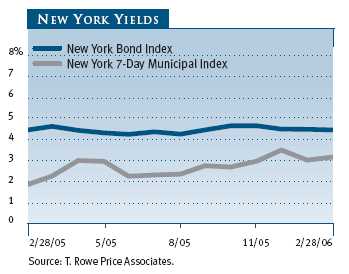
As shown in the graph, New York municipal money market yields rose in tandem with the fed funds rate in the last six months. Intermediate- and long-term rates rose to a lesser extent, resulting in a flatter municipal yield curve, causing longer-term municipal securities to outperform other maturities. The taxable bond market experienced similar trends, but municipal bonds outperformed their taxable counterparts. In the 6- and 12-month periods ended February 28, 2006, the Lehman Brothers Municipal Bond Index returned 0.99% and 3.87%, respectively, versus -0.11% and 2.74% for the Lehman Brothers U.S. Aggregate Index.
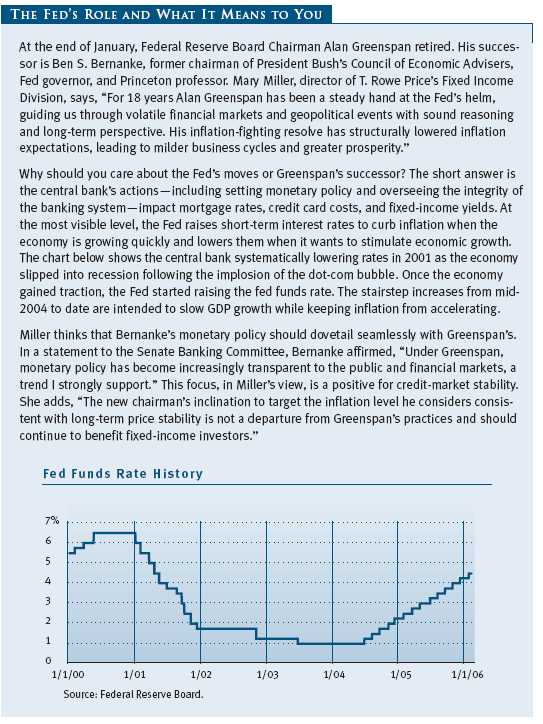
In recent months, there have been growing signs that the end of the Fed’s tightening program may be in sight. According to the minutes and the post-meeting statement for the Fed’s mid-December monetary policy meeting, central bank officials no longer consider monetary policy to be “accommodative,” and they believe that the number of additional interest rate increases “probably would not be large.” In addition, the Treasury yield curve was inverted for most of the last two months, as 10-year yields slipped below two-year yields. Such inversions—which are rare because long-term rates are usually higher than short-term rates to compensate investors for lending money for longer periods—sometimes precede a period of slower economic growth. The municipal yield curve maintained a positive slope but continued to flatten, with only a one-percentage-point difference between municipal money market yields and 30-year municipal bond yields at the end of our reporting period.
MUNICIPAL MARKET NEWS
New municipal borrowing in 2005 totaled a record of more than $400 billion. Nearly half of new issuance was refunding debt, as issuers refinanced older, high-coupon debt to lower their overall interest costs. Despite heavy issuance, demand for tax-free securities remained strong, thanks greatly to institutional investors, hedge funds, and various non-traditional buyers of municipals. Credit quality in the municipal market remains good, as state governments benefited from better-than-expected tax collections stemming from a strong economy. Given higher interest rates, reduced refunding activity, and stronger state tax revenues, municipal issuance in 2006 seems likely to be less robust.
Lower-quality municipal securities outperformed investment-grade issues in the last six months, as yield-hungry investors sought more speculative investments. Airline bonds did well as major carriers have been taking steps to stabilize their cost structures, though the sector remains susceptible to higher fuel costs. Tobacco bonds—which are backed by payments from tobacco companies to the states through the Master Settlement Agreement (MSA)—also performed well, helped by the federal government’s failed bid to reinstate a $280 billion penalty against the tobacco industry and the Illinois Supreme Court’s overturning of an unfavorable ruling against cigarette maker Philip Morris. In the investment-grade sector, BBB and A rated hospital bonds performed extremely well as investors sought their yield advantage. Housing-related bonds also did well as prepayment activity diminished amid rising interest rates.
NEW YORK MARKET NEWS
New York’s economy continues to benefit from slow-but-steady recovery and job gains, with annual unemployment dropping to 5.0% in 2005 from 5.8% in 2004. The state’s overall economic growth is expected to slow, yet remain positive, in 2006 and beyond. In the current fiscal year, revenue collections have been substantially higher than expected, boosted by strong personal income taxes and an estimated record year of Wall Street bonuses. The state expects to end fiscal year 2006, which closes on March 31, with a general fund surplus of approximately $2 billion.
The state continues to struggle with a structural budget imbalance, which occurs when projected revenues are not sufficient to cover future years’ projected expenses. Since Governor George Pataki has announced he will not seek reelection to a fourth term, a new governor will be dealing with this issue after January 2007.
New York’s total outstanding debt has grown to $49.9 billion, ranking the state’s per capita debt and its debt as a percentage of personal income as the nation’s fifth highest, according to Moody’s Investors Service’s 2005 State Debt Medians. The majority of tax-supported debt is “appropriation-backed,” meaning that debt service must be appropriated annually, but the state legislature has no legal obligation to make such appropriations. The state’s direct debt must be approved by voters, and therefore the state has used appropriation-backed debt as “back-door borrowing” to avoid seeking voter approval. Following an upgrade by Moody’s in December 2005, New York’s general obligation (direct) debt is currently rated Aa3 by Moody’s, AA by Standard & Poor’s, and AA- by Fitch Ratings.
New York City currently projects a surplus of $3.3 billion for fiscal year 2006, which ends June 30. The city is enjoying an economic expansion with a strong job recovery, a robust real estate market, and a resurgent tourist trade. Although the total number of jobs in the city has not quite reached its prerecession high, annual unemployment for 2005 was 5.8%, its lowest level since 2000. Mayor Michael Bloomberg has proposed a $52.2 billion budget for fiscal year 2007 that closes an estimated budget imbalance of $2.25 billion. Following upgrades in 2005, New York City has its highest ratings in history—A1 by Moody’s, A+ by S&P, and A+ by Fitch Ratings.
PORTFOLIO STRATEGIESNew York Tax-Free Money Fund
Your fund returned 1.16% for the last six months and 2.09% for the one-year period ended February 28, 2006, outperforming its Lipper benchmark for both periods as shown in the table. As short-term yields rose in response to the Fed’s tightening policy, money fund investors reaped the benefits. Since our August report, the fund’s seven-day simple yield has moved up 62 basis points (100 basis points equal one percentage point) to 2.57%. Fund yields should continue rising until the Fed signals a clear end to its long cycle of monetary tightening.
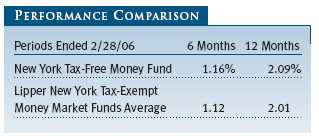
The Federal Reserve’s steady drumbeat of rate increases has made money market yields competitive with the rest of the fixed-income market. Money market rates have begun to approximate and, in some cases, exceed those available to investors in longer-term maturities. In response to these improved yields, investors pushed total industry municipal money fund assets at the end of 2005 to a record level of $355 billion.
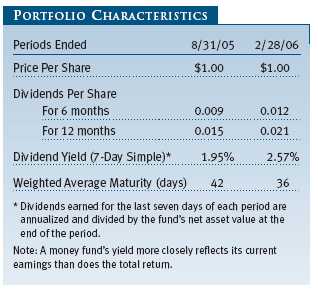
Higher short-term rates have boosted money fund yields and benefited money fund investors. Twelve months ago, the fed funds rate stood at 2.50%, and the one-year Libor, a taxable short-term benchmark, was quoted at 3.53%; overnight municipal yields were 1.79%, and one-year notes traded at 2.35%. By the end of February 2006, the Fed had hiked the fed funds rate to 4.50%, while the one-year Libor rate stood at 5.15%, municipal overnight rates at 2.97%, and one-year notes at 3.40%.
Higher short-term rates have been accompanied by a general flattening of the money market curve. Interestingly, the municipal money market curve has not experienced quite the same flattening seen in the taxable money market. Although the spread between overnight and one-year maturities has narrowed as much as 20 basis points in the taxable market, the same spreads in the municipal market have remained fairly constant at around 38 basis points.
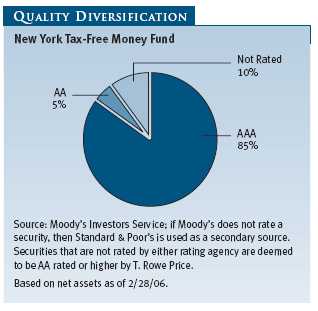
With the steeper municipal yield curve, we maintained a lower portfolio exposure to short-dated, variable rate securities. Instead, we found some yield advantage investing in longer-dated maturities. This positioned the fund somewhat longer than our peers, though in general the posture of the fund remains defensive. The fund ended this reporting period with a weighted average maturity (WAM) of 36 days, compared with 42 days six months earlier.
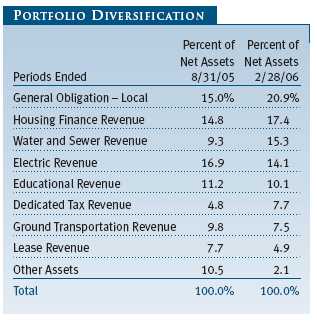
Increased demand for short-term municipal securities continues to reduce the relative yield advantage of municipals compared with taxable alternatives. This relationship—which peaked in 2002 and 2003 when municipals yielded about 90% of a comparable taxable investment—has receded to an average of about 75%. As markets recalibrate at higher interest rate levels, we would expect to see this relationship fall a bit further to the more normal level of about 72%.
With the futures market pricing in at least two more 25-basis-point rate increases by the Federal Reserve, we continue to maintain our defensive posture—one that has served us well over the past year. However, some early signs of economic slowing, such as the cooling of the housing market, may suggest that the Fed’s monetary restraint may finally be having an impact. Therefore, we will remain attuned to signs of further economic slowing and any indications that the Fed is prepared to end this current round of rate increases.
New York Tax-Free Bond Fund
Your fund returned 0.90% for the last six months and 3.80% for the one-year period ended February 28, 2006, outpacing the six-month return of 0.85% and the one-year return of 3.52% for its Lipper peer group average. Our positive performance reflected some restructuring of the portfolio, solid performance of our lower-rated credits, and the ongoing benefits of our low expenses, which are even more critical in the recent low-return environment.
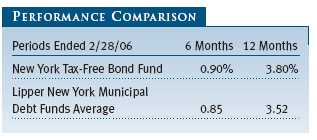
The fund’s long-term record relative to its competitors remains generally favorable. Its average annual returns for the 1-, 3-, 5-, and 10-year periods ended December 31, 2005, were 3.40%, 4.06%, 5.17%, and 5.28%, respectively, versus 3.07%, 3.79%, 4.77%, and 4.83% for its Lipper peer group average. Based on total return, Lipper ranked the New York Tax-Free Bond Fund 26 out of 107, 35 out of 106, 23 out of 90, and 15 out of 64 New York municipal debt funds for the 1-, 3-, 5-, and 10-year periods ended December 31, 2005, respectively. Returns will vary for other periods. Past performance cannot guarantee future results.
Overall, the fund’s structure remained defensive, but less so than it was six months ago, reflecting the rising interest rate environment and signs that the Federal Reserve is close to completing its current tightening cycle. We decreased its weighted average maturity (WAM) by about six months to 14.2 years, slightly higher than the 13.9 years a year ago but down from the 14.4 years at the close of 2005. The fund’s effective duration, a measure of interest rate sensitivity, remained unchanged at 5.1 years and reflects our preference for a slightly defensive interest rate posture. The fund’s weighted average quality remained high. Nearly half of the fund’s holdings carried AAA ratings, and more than 83% were rated A or better.
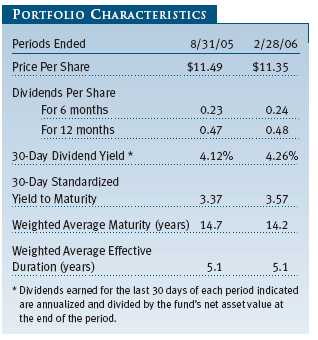
Since our last report, the market’s behavior has not changed. Thanks to investors’ strong demand for yield, higher-yielding issues rated A and lower outperformed the general market. The fund’s lower-rated credits turned in an exemplary performance, and our lower-rated hospital and life care credits were strong performers for the year. While selectively adding to our positions, we maintained an underweight in MSA-backed tobacco debt, which had significantly higher returns than the general market. Our purchase of lower-rated hospital and life care credits compensated somewhat for our smaller exposure to tobacco. Overall, maximizing our exposure to below investment-grade credits, based on prospectus limits, proved beneficial to the fund’s overall performance.
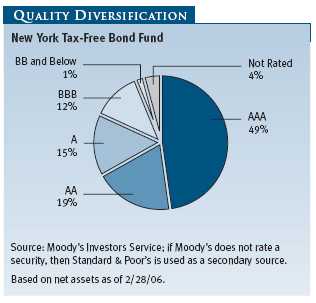
Longer maturities outperformed the general market and were positive contributors to the fund’s performance. With our outlook calling for the Fed to continue to push rates higher, we maintained a barbell portfolio structure—preferring holdings at the short and long ends and avoiding securities in the 3- to 10-year range.
During the past six months, we sold securities in the three-year range and shifted our holdings to 20-year bonds from 30-year bonds. Although the 20-year range outperformed the benchmark, the longer maturities fared even better. Based on market conditions, we plan to add to our longer maturities.
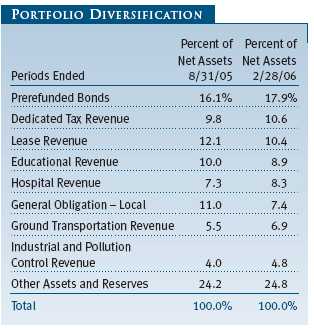
During the past six months, the fund’s sector allocations have shifted. Prerefunded bonds—our largest exposure—increased as existing holdings were refunded. Our proportion of local general obligation bonds dropped as a result of decreasing exposure to New York City and other local credits: this shift had more to do with finding better opportunities along the yield curve rather than any concerns about New York municipalities’ credit quality. In the past six months, we decreased our exposure to debt issued by the Commonwealth of Puerto Rico (tax-exempt for New York taxpayers). The change reflects our increasing concerns over Puerto Rico’s deteriorating credit quality and the possibility of future downgrades.
We are keeping the fund’s duration in the short to neutral range relative to the Lehman Brothers Municipal Bond benchmark and are likely to remain in this mode until the Fed indicates it has finished its tightening cycle. In the coming months, we will look for opportunities to add value along the yield curve and to enhance yield with attractively priced, lower-rated credits.
OUTLOOK
Despite the approaching end of the Federal Reserve’s tightening cycle and a year of moderate returns in 2005, the taxable and municipal bond markets do not appear poised to rally. In fact, given the strong U.S. economy and the current level of interest rates, bond yields may climb modestly. In general, we believe 2006 will be a transition year as interest rates settle into some higher ranges and as yield spreads widen for those taking more risk. The good news for municipal investors will be higher tax-free income, especially from shorter-term bonds. Inflation will be a key driver of interest rates as we wait to see whether the rise in energy prices feeds through into core inflation, which, to date, has remained notably constrained.
We see good value in municipal bonds, which offer yields only slightly below taxable Treasury bond yields even after providing good relative returns this past year. This attractive after-tax return makes them an especially appealing option for those in higher tax brackets. We will continue to use our proprietary research to uncover the best credit opportunities and selectively invest in attractive income-producing investments that we believe will perform well, even if credit spreads should widen from current levels.
Respectfully submitted,

Joseph K. Lynagh
Chairman of the Investment Advisory Committee
New York Tax-Free Money Fund

Konstantine B. Mallas
Chairman of the Investment Advisory Committee
New York Tax-Free Bond Fund
March 20, 2006
The committee chairmen have day-to-day responsibility for managing the portfolios and work with committee members in developing and executing the funds’ investment programs.
RISKS OF FIXED-INCOME INVESTING
Since money market funds are managed to maintain a constant $1.00 share price, there should be little risk of principal loss. However, there is no assurance the fund will avoid principal losses if fund holdings default or are downgraded, or if interest rates rise sharply in an unusually short period. In addition, the fund’s yield will vary; it is not fixed for a specific period like the yield on a bank certificate of deposit. An investment in the fund is not insured or guaranteed by the Federal Deposit Insurance Corporation (FDIC) or any other government agency. Although a money market fund seeks to preserve the value of your investment at $1.00 per share, it is possible to lose money by investing in it.
Bonds are subject to interest rate risk (the decline in bond prices that usually accompanies a rise in interest rates) and credit risk (the chance that any fund holding could have its credit rating downgraded, or that a bond issuer will default by failing to make timely payments of interest or principal), potentially reducing the fund’s income level and share price.
GLOSSARY
Appropriation-backed bonds: Long-term obligations sold under a variety of financial arrangements—primarily lease-purchase and contractual service agreements used to finance capital projects. Debt service on such obligations is appropriated annually by the state, although the state has no legal obligation to continue to make such appropriations.
Average maturity: For a bond fund, the average of the stated maturity dates of the portfolio’s securities. In general, the longer the average maturity, the greater the fund’s sensitivity to interest rate changes, which means greater price fluctuation. A shorter average maturity usually means a less sensitive and, consequently, less volatile portfolio.
Basis point: One hundred basis points equal one percentage point.
Duration: A measure of a bond fund’s sensitivity to changes in interest rates. For example, a fund with a duration of 6 years would fall about 6% in price in response to a one-percentage-point rise in interest rates, and vice versa.
Fed funds target rate: An overnight lending rate set by the Federal Reserve and used by banks to meet reserve requirements. Banks also use the fed funds rate as a benchmark for their prime lending rates.
General obligation debt: A government’s strongest pledge that obligates its full faith and credit, including, if necessary, its ability to raise taxes.
Lehman Brothers Municipal Bond Index: An unmanaged index that includes investment-grade, tax-exempt, and fixed-rate bonds with long-term maturities selected from issues larger than $50 million.
Lehman Brothers U.S. Aggregate Index: An unmanaged index made up of the Lehman Brothers Government/Corporate Bond Index, Mortgage-Backed Securities Index, and Asset-Backed Securities Index, including securities of investment-grade quality or better, with at least one year to maturity, and an outstanding par value of at least $100 million.Libor: The London Interbank Offered Rate is a benchmark for short-term taxable rates.
Lipper averages: The averages of available mutual fund performance returns for specified time periods in defined categories as tracked by Lipper Inc.
Prerefunded bond: A bond that originally may have been issued as a general obligation or revenue bond but that is now secured by an escrow fund consisting entirely of direct U.S. government obligations that are sufficient for paying the bondholders.
This chart shows the value of a hypothetical $10,000 investment in the fund over the past 10 fiscal year periods or since inception (for funds lacking 10-year records). The result is compared with benchmarks, which may include a broad-based market index and a peer group average or index. Market indexes do not include expenses, which are deducted from fund returns as well as mutual fund averages and indexes.
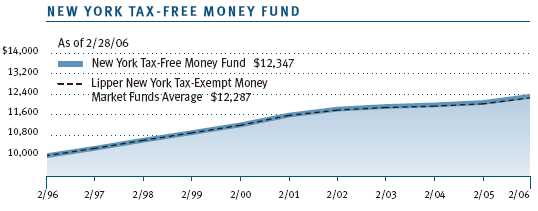
| AVERAGE ANNUAL COMPOUND TOTAL RETURN |
This table shows how the fund would have performed each year if its actual (or cumulative) returns for the periods shown had been earned at a constant rate.

This chart shows the value of a hypothetical $10,000 investment in the fund over the past 10 fiscal year periods or since inception (for funds lacking 10-year records). The result is compared with benchmarks, which may include a broad-based market index and a peer group average or index. Market indexes do not include expenses, which are deducted from fund returns as well as mutual fund averages and indexes.
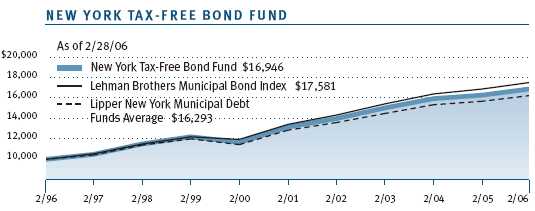
| AVERAGE ANNUAL COMPOUND TOTAL RETURN |
This table shows how the fund would have performed each year if its actual (or cumulative) returns for the periods shown had been earned at a constant rate.

As a mutual fund shareholder, you may incur two types of costs: (1) transaction costs, such as redemption fees or sales loads, and (2) ongoing costs, including management fees, distribution and service (12b-1) fees, and other fund expenses. The following example is intended to help you understand your ongoing costs (in dollars) of investing in the fund and to compare these costs with the ongoing costs of investing in other mutual funds. The example is based on an investment of $1,000 invested at the beginning of the most recent six-month period and held for the entire period.
Actual Expenses
The first line of the following table (“Actual”) provides information about actual account values and actual expenses. You may use the information in this line, together with your account balance, to estimate the expenses that you paid over the period. Simply divide your account value by $1,000 (for example, an $8,600 account value divided by $1,000 = 8.6), then multiply the result by the number in the first line under the heading “Expenses Paid During Period” to estimate the expenses you paid on your account during this period.
Hypothetical Example for Comparison Purposes
The information on the second line of the table (“Hypothetical”) is based on hypothetical account values and expenses derived from the fund’s actual expense ratio and an assumed 5% per year rate of return before expenses (not the fund’s actual return). You may compare the ongoing costs of investing in the fund with other funds by contrasting this 5% hypothetical example and the 5% hypothetical examples that appear in the shareholder reports of the other funds. The hypothetical account values and expenses may not be used to estimate the actual ending account balance or expenses you paid for the period.
Note: T. Rowe Price charges an annual small-account maintenance fee of $10, generally for accounts with less than $2,000 ($500 for UGMA/UTMA). The fee is waived for any investor whose T. Rowe Price mutual fund accounts total $25,000 or more, accounts employing automatic investing, and IRAs and other retirement plan accounts that utilize a prototype plan sponsored by T. Rowe Price (although a separate custodial or administrative fee may apply to such accounts). This fee is not included in the accompanying table. If you are subject to the fee, keep it in mind when you are estimating the ongoing expenses of investing in the fund and when comparing the expenses of this fund with other funds.
You should also be aware that the expenses shown in the table highlight only your ongoing costs and do not reflect any transaction costs, such as redemption fees or sales loads. Therefore, the second line of the table is useful in comparing ongoing costs only and will not help you determine the relative total costs of owning different funds. To the extent a fund charges transaction costs, however, the total cost of owning that fund is higher.
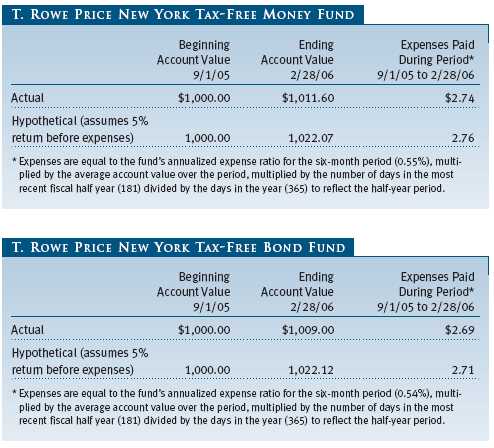
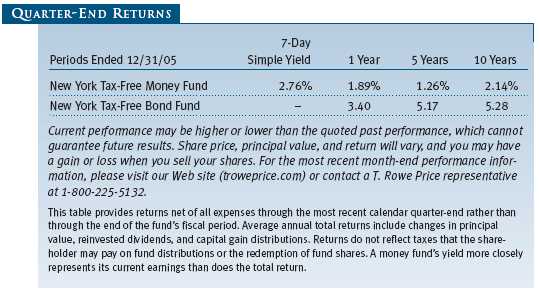
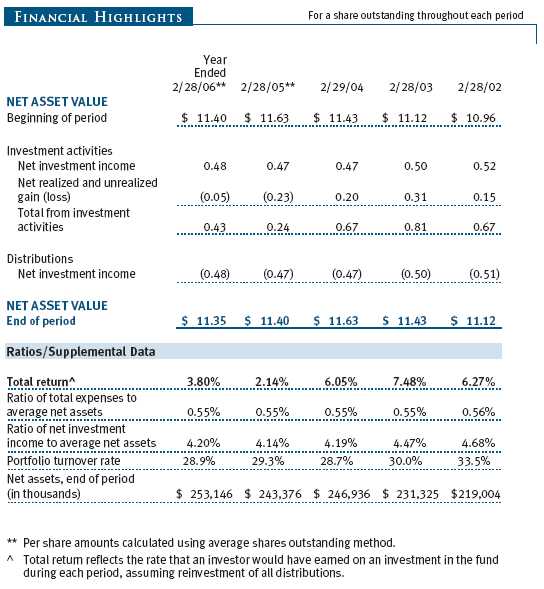
The accompanying notes are an integral part of these financial statements.

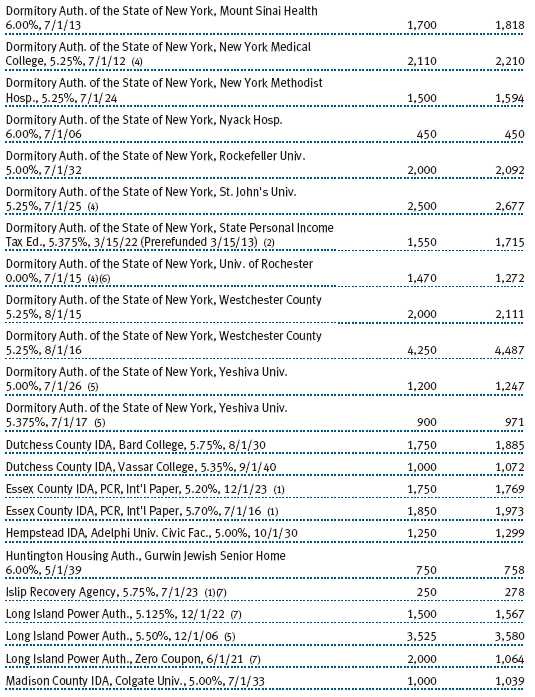
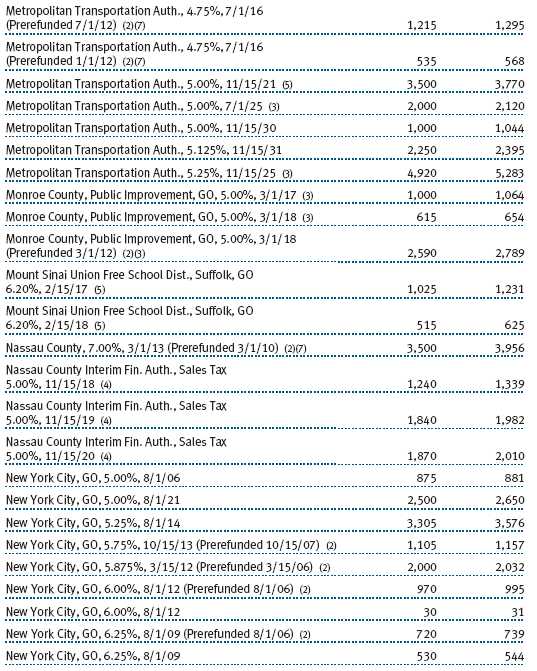
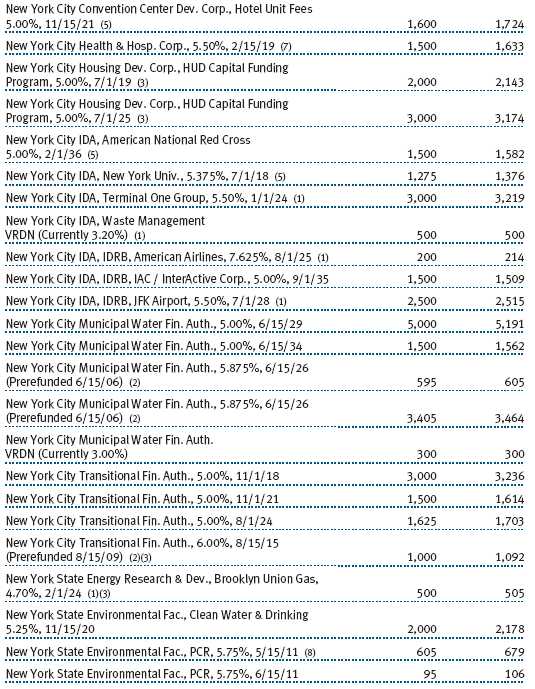
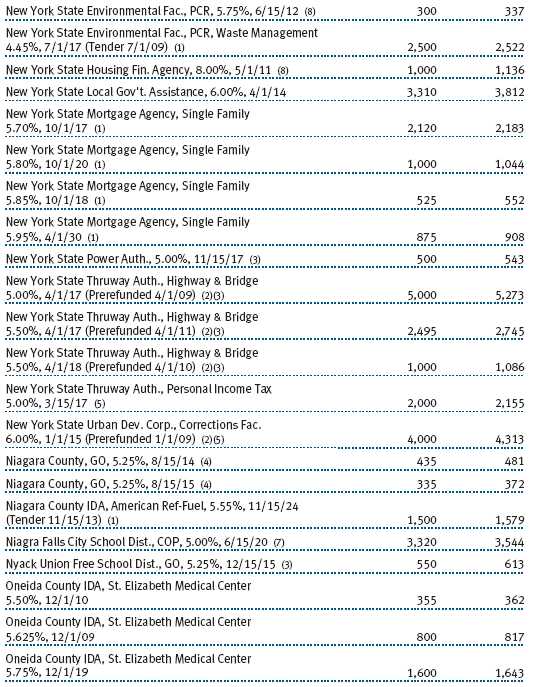
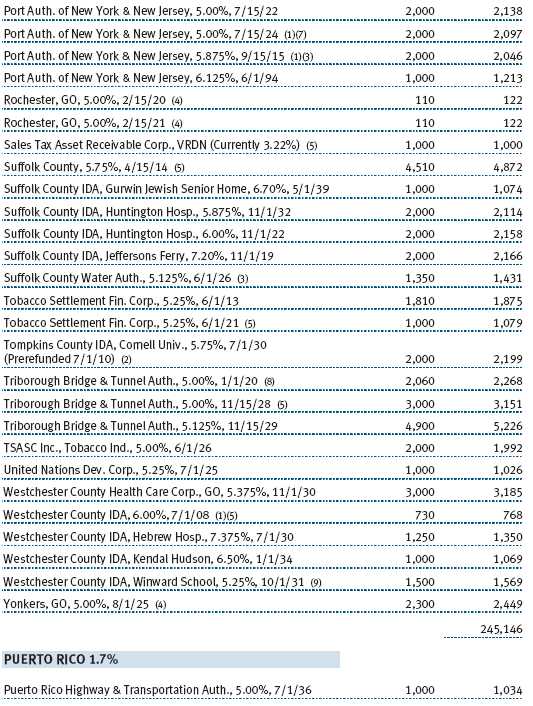
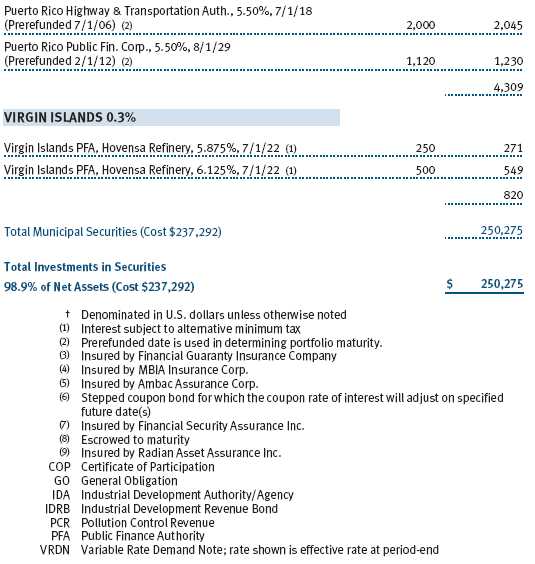
The accompanying notes are an integral part of these financial statements.
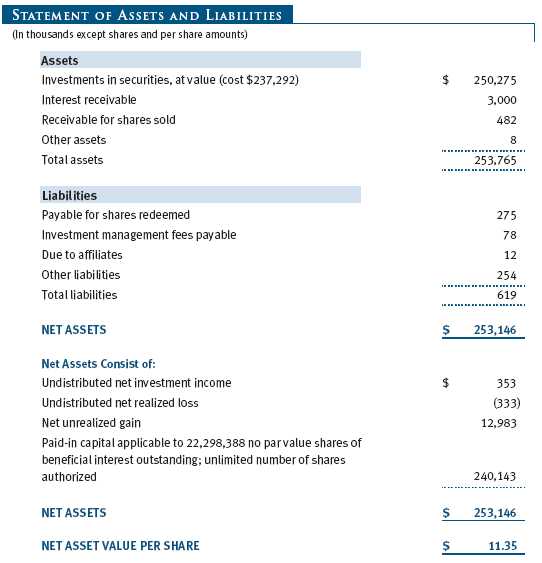
The accompanying notes are an integral part of these financial statements.
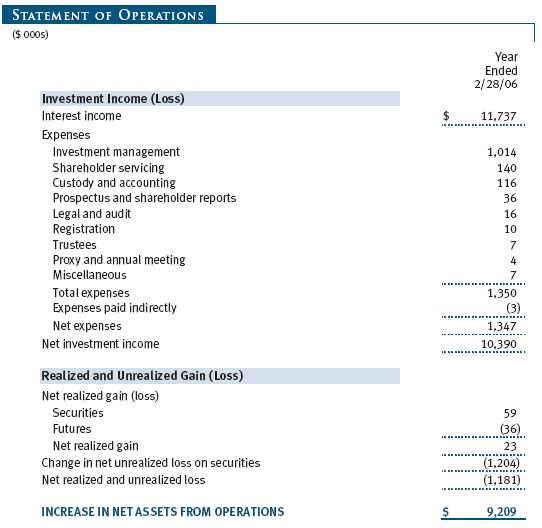
The accompanying notes are an integral part of these financial statements.
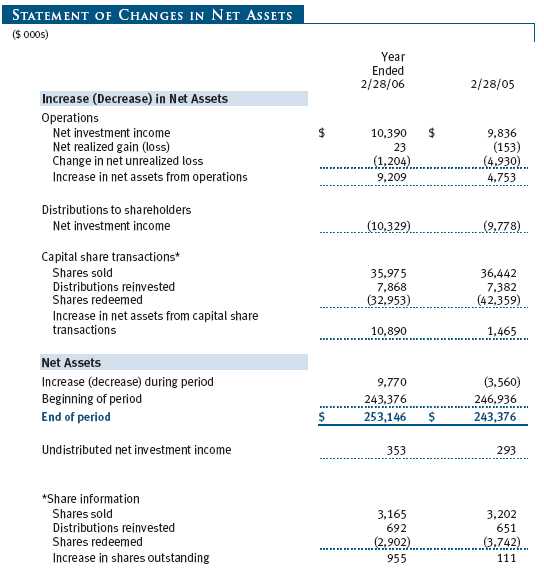
The accompanying notes are an integral part of these financial statements.
| NOTES TO FINANCIAL STATEMENTS |
NOTE 1 - SIGNIFICANT ACCOUNTING POLICIES
T. Rowe Price State Tax-Free Income Trust (the trust) is registered under the Investment Company Act of 1940 (the 1940 Act). The New York Tax-Free Bond Fund (the fund), a nondiversified, open-end management investment company, is one portfolio established by the trust. The fund commenced operations on August 28, 1986. The fund seeks to provide, consistent with prudent portfolio management, the highest level of income exempt from federal, New York state, and New York City income taxes, by investing primarily in investment-grade New York municipal bonds.
The accompanying financial statements were prepared in accordance with accounting principles generally accepted in the United States of America, which require the use of estimates made by fund management. Fund management believes that estimates and security valuations are appropriate; however, actual results may differ from those estimates, and the security valuations reflected in the financial statements may differ from the value the fund ultimately realizes upon sale of the securities.
Valuation The fund values its investments and computes its net asset value per share at the close of the New York Stock Exchange (NYSE), normally 4 p.m. ET, each day that the NYSE is open for business. Debt securities are generally traded in the over-the-counter market. Securities are valued at prices furnished by dealers who make markets in such securities or by an independent pricing service, which considers yield or price of bonds of comparable quality, coupon, maturity, and type, as well as prices quoted by dealers who make markets in such securities.
Financial futures contracts are valued at closing settlement prices.
Other investments, including restricted securities, and those for which the above valuation procedures are inappropriate or are deemed not to reflect fair value are stated at fair value as determined in good faith by the T. Rowe Price Valuation Committee, established by the fund’s Board of Trustees.
Credits The fund earns credits on temporarily uninvested cash balances at the custodian that reduce the fund’s custody charges. Custody expense in the accompanying financial statements is presented before reduction for credits, which are reflected as expenses paid indirectly.
Investment Transactions, Investment Income, and Distributions Income and expenses are recorded on the accrual basis. Premiums and discounts on debt securities are amortized for financial reporting purposes. Investment transactions are accounted for on the trade date. Realized gains and losses are reported on the identified cost basis. Payments (“variation margin”) made or received to settle the daily fluctuations in the value of futures contracts are recorded as unrealized gains or losses until the contracts are closed. Distributions to shareholders are recorded on the ex-dividend date. Income distributions are declared on a daily basis and paid monthly. Capital gain distributions, if any, are declared and paid by the fund, typically on an annual basis.
NOTE 2 - INVESTMENT TRANSACTIONS
Consistent with its investment objective, the fund engages in the following practices to manage exposure to certain risks or enhance performance. The investment objective, policies, program, and risk factors of the fund are described more fully in the fund’s prospectus and Statement of Additional Information.
Futures Contracts During the year ended February 28, 2006, the fund was a party to futures contracts, which provide for the future sale by one party and purchase by another of a specified amount of a specific financial instrument at an agreed upon price, date, time, and place. Risks arise from possible illiquidity of the futures market and from movements in security values and/or interest rates.
Other Purchases and sales of portfolio securities, other than short-term securities, aggregated $86,267,000 and $69,122,000, respectively, for the year ended February 28, 2006.
NOTE 3 - FEDERAL INCOME TAXES
No provision for federal income taxes is required since the fund intends to continue to qualify as a regulated investment company under Subchapter M of the Internal Revenue Code and distribute to shareholders all of its income and gains. Federal income tax regulations differ from generally accepted accounting principles; therefore, distributions determined in accordance with tax regulations may differ significantly in amount or character from net investment income and realized gains for financial reporting purposes. Financial reporting records are adjusted for permanent book/tax differences to reflect tax character. Financial records are not adjusted for temporary differences.
Distributions during the year ended February 28, 2006, totaled $10,329,000 and were characterized as tax-exempt income for tax purposes. At February 28, 2006, the tax-basis components of net assets were as follows:

Federal income tax regulations require the fund to defer recognition of capital losses realized on certain covered futures transactions; accordingly, $293,000 of realized losses reflected in the accompanying financial statements have not been recognized for tax purposes as of February 28, 2006. For federal income tax purposes, market discount is recognized as income at the time of sale in the amount of the lesser of gain or scheduled amortization. Accordingly, at February 28, 2006, amortization of $301,000 that has been recognized as income for financial reporting purposes is treated as unrealized appreciation for tax purposes.
For the year ended February 28, 2006, the fund recorded the following permanent reclassifications to reflect tax character. Reclassifications to paid-in capital relate primarily to a tax practice that treats a portion of the proceeds from each redemption of capital shares as a distribution of taxable net investment income and/or realized capital gain. Results of operations and net assets were not affected by these reclassifications.

At February 28, 2006, the cost of investments for federal income tax purposes was $237,324,000.
NOTE 4 - RELATED PARTY TRANSACTIONS
The fund is managed by T. Rowe Price Associates, Inc. (the manager or Price Associates), a wholly owned subsidiary of T. Rowe Price Group, Inc. The investment management agreement between the fund and the manager provides for an annual investment management fee, which is computed daily and paid monthly. The fee consists of an individual fund fee, equal to 0.10% of the fund’s average daily net assets, and a group fee. The group fee rate is calculated based on the combined net assets of certain mutual funds sponsored by Price Associates (the group) applied to a graduated fee schedule, with rates ranging from 0.48% for the first $1 billion of assets to 0.29% for assets in excess of $160 billion. Prior to May 1, 2005, the maximum group fee rate in the graduated fee schedule had been 0.295% for assets in excess of $120 billion. The fund’s group fee is determined by applying the group fee rate to the fund’s average daily net assets. At February 28, 2006, the effective annual group fe e rate was 0.31%.
In addition, the fund has entered into service agreements with Price Associates and a wholly owned subsidiary of Price Associates (collectively, Price). Price Associates computes the daily share price and provides certain other administrative services to the fund. T. Rowe Price Services, Inc., provides shareholder and administrative services in its capacity as the fund’s transfer and dividend disbursing agent. For the year ended February 28, 2006, expenses incurred pursuant to these service agreements were $69,000 for Price Associates and $99,000 for T. Rowe Price Services. The total amount payable at period end pursuant to these service agreements is reflected as Due to Affiliates in the accompanying financial statements.
| REPORT OF INDEPENDENT REGISTERED PUBLIC ACCOUNTING FIRM |
To the Board of Trustees of T. Rowe Price State Tax-Free Income Trust and Shareholders of T. Rowe Price New York Tax-Free Bond Fund
In our opinion, the accompanying statement of assets and liabilities, including the portfolio of investments, and the related statements of operations and of changes in net assets and the financial highlights present fairly, in all material respects, the financial position of T. Rowe Price New York Tax-Free Bond Fund (one of the portfolios comprising T. Rowe Price State Tax-Free Income Trust, hereafter referred to as the “Fund”) at February 28, 2006, the results of its operations for the year then ended, the changes in its net assets for each of the two years in the period then ended and the financial highlights for each of the five years in the period then ended, in conformity with accounting principles generally accepted in the United States of America. These financial statements and financial highlights (hereafter referred to as “financial statements”) are the responsibility of the Fund’s management; our responsibility is to express an opinion on these financial statements based on our audits. We conducted our audits of these financial statements in accordance with the standards of the Public Company Accounting Oversight Board (United States). Those standards require that we plan and perform the audit to obtain reasonable assurance about whether the financial statements are free of material misstatement. An audit includes examining, on a test basis, evidence supporting the amounts and disclosures in the financial statements, assessing the accounting principles used and significant estimates made by management, and evaluating the overall financial statement presentation. We believe that our audits, which included confirmation of securities at February 28, 2006 by correspondence with the custodian, provide a reasonable basis for our opinion.
PricewaterhouseCoopers LLP
Baltimore, Maryland
April 10, 2006
| TAX INFORMATION (UNAUDITED) FOR THE TAX YEAR ENDED 2/28/06 |
We are providing this information as required by the Internal Revenue Code. The amounts shown may differ from those elsewhere in this report because of differences between tax and financial reporting requirements.
The fund’s distributions to shareholders included:
• $35,000 from long-term capital gains, subject to the 15% rate gains category
• $10,247,000 which qualified as exempt-interest dividends.
| INFORMATION ON PROXY VOTING POLICIES, PROCEDURES, AND RECORDS |
A description of the policies and procedures used by T. Rowe Price funds and portfolios to determine how to vote proxies relating to portfolio securities is available in each fund’s Statement of Additional Information, which you may request by calling 1-800-225-5132 or by accessing the SEC’s Web site, www.sec.gov. The description of our proxy voting policies and procedures is also available on our Web site, www.troweprice.com. To access it, click on the words “Company Info” at the top of our homepage for individual investors. Then, in the window that appears, click on the “Proxy Voting Policy” navigation button in the top left corner.
Each fund’s most recent annual proxy voting record is available on our Web site and through the SEC’s Web site. To access it through our Web site, follow the directions above, then click on the words “Proxy Voting Record” at the bottom of the Proxy Voting Policy page.
| HOW TO OBTAIN QUARTERLY PORTFOLIO HOLDINGS |
The fund files a complete schedule of portfolio holdings with the Securities and Exchange Commission for the first and third quarters of each fiscal year on Form N-Q. The fund’s Form N-Q is available electronically on the SEC’s Web site (www.sec.gov); hard copies may be reviewed and copied at the SEC’s Public Reference Room, 450 Fifth St. N.W., Washington, DC 20549. For more information on the Public Reference Room, call 1-800-SEC-0330.
| ABOUT THE FUND’S TRUSTEES AND OFFICERS |
Your fund is governed by a Board of Trustees that meets regularly to review performance, investment programs, compliance matters, advisory fees and expenses, service providers, and other business matters, and is responsible for protecting the interests of shareholders. At least 75% of the fund’s trustees are independent of T. Rowe Price Associates, Inc. (T. Rowe Price); “inside” trustees are officers of T. Rowe Price. The Board of Trustees elects the fund’s officers, who are listed in the final table. The business address of each trustee and officer is 100 East Pratt Street, Baltimore, MD 21202. The Statement of Additional Information includes additional information about the fund trustees and is available without charge by calling a T. Rowe Price representative at 1-800-225-5132.
| Independent Trustees | |
| |
| Name | |
| (Year of Birth) | |
| Year Elected* | |
| [Number of T. Rowe Price | Principal Occupation(s) During Past 5 Years and Directorships of |
| Portfolios Overseen] | Other Public Companies |
| |
| Anthony W. Deering | Chairman, Exeter Capital, LLC, a private investment firm (2004 to |
| (1945) | present); Director, Vornado Real Estate Investment Trust (3/04 to |
| 1986 | present); Director, Mercantile Bankshares (4/03 to present); Member, |
| [113] | Advisory Board, Deutsche Bank North America (2004 to present); |
| | Director, Chairman of the Board, and Chief Executive Officer, The |
| | Rouse Company, real estate developers (1997 to 2004) |
| |
| Donald W. Dick, Jr. | Principal, EuroCapital Advisors, LLC, an acquisition and management |
| (1943) | advisory firm; Chairman, President, and Chief Executive Officer, The |
| 2001 | Haven Group, a custom manufacturer of modular homes (1/04 to |
| [113] | present) |
| |
| David K. Fagin | Chairman and President, Nye Corporation (6/88 to present); Director, |
| (1938) | Canyon Resources Corp. and Golden Star Resources Ltd. (5/92 to |
| 2001 | present), and Pacific Rim Mining Corp. (2/02 to present) |
| [113] | |
| |
| Karen N. Horn | Managing Director and President, Global Private Client Services, |
| (1943) | Marsh Inc. (1999 to 2003); Managing Director and Head of |
| 2003 | International Private Banking, Bankers Trust (1996 to 1999); Director, |
| [113] | Georgia Pacific, Eli Lilly and Company, and Simon Property Group |
| |
| Theo C. Rodgers | President, A&R Development Corporation |
| (1941) | |
| 2005 | |
| [97] | |
| | |
| John G. Schreiber | Owner/President, Centaur Capital Partners, Inc., a real estate invest- |
| (1946) | ment company; Partner, Blackstone Real Estate Advisors, L.P.; |
| 1992 | Director, AMLI Residential Properties Trust |
| [113] | |
| * Each independent trustee serves until retirement, resignation, or election of a successor. |
| Inside Trustees | |
| |
| Name | |
| (Year of Birth) | |
| Year Elected* | |
| [Number of T. Rowe Price | Principal Occupation(s) During Past 5 Years and Directorships of |
| Portfolios Overseen] | Other Public Companies |
| |
| Mary J. Miller | Director and Vice President, T. Rowe Price; Vice President, T. Rowe |
| (1955) | Price Group, Inc.; President, State Tax-Free Income Trust |
| 2004 | |
| [37] | |
| |
| James S. Riepe | Chairman of the Board and Director, T. Rowe Price Investment |
| (1943) | Services, Inc.; Director, T. Rowe Price Group, Inc.; Chairman of the |
| 1986 | Board, all funds |
| [113] | |
| * Each inside trustee serves until retirement, resignation, or election of a successor. |
| Officers | |
| |
| Name (Year of Birth) | |
| Title and Fund(s) Served | Principal Occupation(s) |
| |
| Steven G. Brooks, CFA (1954) | Vice President, T. Rowe Price and T. Rowe Price |
| Vice President, State Tax-Free Income Trust | Group, Inc. |
| |
| Joseph A. Carrier, CPA (1960) | Vice President, T. Rowe Price, T. Rowe Price |
| Treasurer, State Tax-Free Income Trust | Group, Inc., T. Rowe Price Investment Services, |
| | Inc., and T. Rowe Price Trust Company |
| |
| Jonathan M. Chirunga (1966) | Vice President, T. Rowe Price |
| Vice President, State Tax-Free Income Trust | |
| |
| M. Helena Condez (1962) | Assistant Vice President, T. Rowe Price |
| Assistant Vice President, State Tax-Free | |
| Income Trust | |
| |
| G. Richard Dent (1960) | Vice President, T. Rowe Price and T. Rowe Price |
| Vice President, State Tax-Free Income Trust | Group, Inc. |
| |
| Roger L. Fiery III, CPA (1959) | Vice President, T. Rowe Price, T. Rowe Price |
| Vice President, State Tax-Free Income Trust | Group, Inc., T. Rowe Price International, Inc., |
| | and T. Rowe Price Trust Company |
| |
| John R. Gilner (1961) | Chief Compliance Officer and Vice President, |
| Chief Compliance Officer, State Tax-Free | T. Rowe Price; Vice President, T. Rowe Price |
| Income Trust | Group, Inc., and T. Rowe Price Investment |
| | Services, Inc. |
| |
| Gregory S. Golczewski (1966) | Vice President, T. Rowe Price and T. Rowe Price |
| Vice President, State Tax-Free Income Trust | Trust Company |
| |
| Charles B. Hill, CFA (1961) | Vice President, T. Rowe Price and T. Rowe Price |
| Executive Vice President, State Tax-Free | Group, Inc. |
| Income Trust | |
| |
| Henry H. Hopkins (1942) | Director and Vice President, T. Rowe Price |
| Vice President, State Tax-Free Income Trust | Investment Services, Inc., T. Rowe Price |
| | Services, Inc., and T. Rowe Price Trust Company; |
| | Vice President, T. Rowe Price, T. Rowe Price |
| | Group, Inc., T. Rowe Price International, Inc., and |
| | T. Rowe Price Retirement Plan Services, Inc. |
| |
| T. Dylan Jones (1971) | Assistant Vice President, T. Rowe Price |
| Assistant Vice President, State Tax-Free | |
| Income Trust | |
| | |
| Philip J. Kligman, CFA (1974) | Assistant Vice President, T. Rowe Price |
| Assistant Vice President, State Tax-Free | |
| Income Trust | |
| |
| Marcy M. Lash (1963) | Vice President, T. Rowe Price and T. Rowe Price |
| Vice President, State Tax-Free Income Trust | Group, Inc. |
| |
| Alan D. Levenson, Ph.D. (1958) | Vice President, T. Rowe Price and T. Rowe Price |
| Vice President, State Tax-Free Income Trust | Group, Inc. |
| |
| Patricia B. Lippert (1953) | Assistant Vice President, T. Rowe Price and |
| Secretary, State Tax-Free Income Trust | T. Rowe Price Investment Services, Inc. |
| |
| Joseph K. Lynagh, CFA (1958) | Vice President, T. Rowe Price and T. Rowe Price |
| Executive Vice President, State Tax-Free | Group, Inc. |
| Income Trust | |
| |
| Konstantine B. Mallas (1963) | Vice President, T. Rowe Price and T. Rowe Price |
| Executive Vice President, State Tax-Free | Group, Inc. |
| Income Trust | |
| |
| James M. McDonald (1949) | Vice President, T. Rowe Price, T. Rowe Price |
| Vice President, State Tax-Free Income Trust | Group, Inc., and T. Rowe Price Trust Company |
| |
| Hugh D. McGuirk, CFA (1960) | Vice President, T. Rowe Price and T. Rowe Price |
| Executive Vice President, State Tax-Free | Group, Inc. |
| Income Trust | |
| |
| Linda A. Murphy (1959) | Vice President, T. Rowe Price and T. Rowe Price |
| Vice President, State Tax-Free Income Trust | Group, Inc. |
| |
| Timothy G. Taylor, CFA (1975) | Assistant Vice President, T. Rowe Price |
| Assistant Vice President, State Tax-Free | |
| Income Trust | |
| |
| Julie L. Waples (1970) | Vice President, T. Rowe Price |
| Vice President, State Tax-Free Income Trust | |
| Unless otherwise noted, officers have been employees of T. Rowe Price or T. Rowe Price International for at least |
| five years. |
Item 2. Code of Ethics.The registrant has adopted a code of ethics, as defined in Item 2 of Form N-CSR, applicable to its principal executive officer, principal financial officer, principal accounting officer or controller, or persons performing similar functions. A copy of this code of ethics is filed as an exhibit to this Form N-CSR. No substantive amendments were approved or waivers were granted to this code of ethics during the period covered by this report.
Item 3. Audit Committee Financial Expert.
The registrant’s Board of Directors/Trustees has determined that Mr. Donald W. Dick Jr. qualifies as an audit committee financial expert, as defined in Item 3 of Form N-CSR. Mr. Dick is considered independent for purposes of Item 3 of Form N-CSR.
Item 4. Principal Accountant Fees and Services.
(a) – (d) Aggregate fees billed to the registrant for the last two fiscal years for professional services rendered by the registrant’s principal accountant were as follows:
| | 2006 | 2005 |
| Audit Fees | $7,901 | $7,067 |
| Audit-Related Fees | 643 | 807 |
| Tax Fees | 2,249 | 2,058 |
| All Other Fees | 418 | - |
Audit fees include amounts related to the audit of the registrant’s annual financial statements and services normally provided by the accountant in connection with statutory and regulatory filings. Audit-related fees include amounts reasonably related to the performance of the audit of the registrant’s financial statements and specifically include the issuance of a report on internal controls. Tax fees include amounts related to services for tax compliance, tax planning, and tax advice. The nature of these services specifically includes the review of distribution calculations and the preparation of Federal, state, and excise tax returns. All other fees include the registrant’s pro-rata share of amounts for agreed-upon procedures in conjunction with service contract approvals by the registrant’s Board of Directors/Trustees.
(e)(1) The registrant’s audit committee has adopted a policy whereby audit and non-audit services performed by the registrant’s principal accountant for the registrant, its investment adviser, and any entity controlling, controlled by, or under common control with the investment adviser that provides ongoing services to the registrant require pre-approval in advance at regularly scheduled audit committee meetings. If such a service is required between regularly scheduled audit committee meetings, pre-approval may be authorized by one audit committee member with ratification at the next scheduled audit committee meeting. Waiver of pre-approval for audit or non-audit services requiring fees of a de minimis amount is not permitted.
(2) No services included in (b) – (d) above were approved pursuant to paragraph (c)(7)(i)(C) of Rule 2-01 of Regulation S-X.
(f) Less than 50 percent of the hours expended on the principal accountant’s engagement to audit the registrant’s financial statements for the most recent fiscal year were attributed to work performed by persons other than the principal accountant’s full-time, permanent employees.
(g) The aggregate fees billed for the most recent fiscal year and the preceding fiscal year by the registrant’s principal accountant for non-audit services rendered to the registrant, its investment adviser, and any entity controlling, controlled by, or under common control with the investment adviser that provides ongoing services to the registrant were $1,008,000 and $903,000, respectively, and were less than the aggregate fees billed for those same periods by the registrant’s principal accountant for audit services rendered to the T. Rowe Price Funds.
(h) All non-audit services rendered in (g) above were pre-approved by the registrant’s audit committee. Accordingly, these services were considered by the registrant’s audit committee in maintaining the principal accountant’s independence.Item 5. Audit Committee of Listed Registrants.
Not applicable.
Item 6. Schedule of Investments.
Not applicable. The complete schedule of investments is included in Item 1 of this Form N-CSR.
Item 7. Disclosure of Proxy Voting Policies and Procedures for Closed-End Management Investment Companies.
Not applicable.
Item 8. Portfolio Managers of Closed-End Management Investment Companies.
Not applicable.
Item 9. Purchases of Equity Securities by Closed-End Management Investment Company and Affiliated Purchasers.
Not applicable.
Item 10. Submission of Matters to a Vote of Security Holders.
Not applicable.
Item 11. Controls and Procedures.
(a) The registrant’s principal executive officer and principal financial officer have evaluated the registrant’s disclosure controls and procedures within 90 days of this filing and have concluded that the registrant’s disclosure controls and procedures were effective, as of that date, in ensuring that information required to be disclosed by the registrant in this Form N-CSR was recorded, processed, summarized, and reported timely.
(b) The registrant’s principal executive officer and principal financial officer are aware of no change in the registrant’s internal control over financial reporting that occurred during the registrant’s second fiscal quarter covered by this report that has materially affected, or is reasonably likely to materially affect, the registrant’s internal control over financial reporting.
Item 12. Exhibits.
(a)(1) The registrant’s code of ethics pursuant to Item 2 of Form N-CSR is attached.
(2) Separate certifications by the registrant's principal executive officer and principal financial officer, pursuant to Section 302 of the Sarbanes-Oxley Act of 2002 and required by Rule 30a-2(a) under the Investment Company Act of 1940, are attached.
(3) Written solicitation to repurchase securities issued by closed-end companies: not applicable.
(b) A certification by the registrant's principal executive officer and principal financial officer, pursuant to Section 906 of the Sarbanes-Oxley Act of 2002 and required by Rule 30a-2(b) under the Investment Company Act of 1940, is attached.
| | |
SIGNATURES |
| |
| | Pursuant to the requirements of the Securities Exchange Act of 1934 and the Investment |
| Company Act of 1940, the registrant has duly caused this report to be signed on its behalf by the |
| undersigned, thereunto duly authorized. |
| |
| T. Rowe Price State Tax-Free Income Trust |
| |
| By | /s/ James S. Riepe |
| | James S. Riepe |
| | Principal Executive Officer |
| |
| Date | April 13, 2006 |
| |
| |
| | Pursuant to the requirements of the Securities Exchange Act of 1934 and the Investment |
| Company Act of 1940, this report has been signed below by the following persons on behalf of |
| the registrant and in the capacities and on the dates indicated. |
| |
| |
| By | /s/ James S. Riepe |
| | James S. Riepe |
| | Principal Executive Officer |
| |
| Date | April 13, 2006 |
| |
| |
| |
| By | /s/ Joseph A. Carrier |
| | Joseph A. Carrier |
| | Principal Financial Officer |
| |
| Date | April 13, 2006 |































